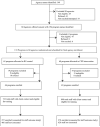Participation in Training for Depression Care Quality Improvement: A Randomized Trial of Community Engagement or Technical Support
- PMID: 25930037
- PMCID: PMC4582783
- DOI: 10.1176/appi.ps.201400099
Participation in Training for Depression Care Quality Improvement: A Randomized Trial of Community Engagement or Technical Support
Abstract
Objective: Community engagement and planning (CEP) could improve dissemination of depression care quality improvement in underresourced communities, but whether its effects on provider training participation differ from those of standard technical assistance, or resources for services (RS), is unknown. This study compared program- and staff-level participation in depression care quality improvement training among programs enrolled in CEP, which trained networks of health care and social-community agencies jointly, and RS, which provided technical support to individual programs.
Methods: Matched programs from health care and social-community service sectors in two communities were randomly assigned to RS or CEP. Data were from 1,622 eligible staff members from 95 enrolled programs. Primary outcomes were any staff trained (for programs) and total hours of training (for staff). Secondary staff-level outcomes were hours of training in specific depression collaborative care components.
Results: CEP programs were more likely than RS programs to participate in any training (p=.006). Within health care sectors, CEP programs were more likely than RS programs to participate in training (p=.016), but within social-community sectors, there was no difference in training by intervention. Among staff who participated in training, mean training hours were greater among CEP programs versus RS programs for any type of training (p<.001) and for training related to each component of depression care (p<.001) except medication management.
Conclusions: CEP may be an effective strategy to promote staff participation in depression care improvement efforts in underresourced communities.
Figures
References
-
- Murray CJ, Vos T, Lozano R, et al. Disability-adjusted life years (DALYs) for 291 diseases and injuries in 21 regions, 1990-2010: a systematic analysis for the Global Burden of Disease Study 2010. Lancet. 2012;380:2197–2223. - PubMed
-
- Lopez AD, Mathers CD, Ezzati M, et al. Global and regional burden of disease and risk factors, 2001: systematic analysis of population health data. Lancet. 2006;367:1747–1757. - PubMed
-
- Wang PS, M. L, Olfson M, Pincus HA, et al. Twelve-month use of mental health services in the United States: results from the National Comorbidity Survey Replication. Archives of General Psychiatry. 2005;62:590–602. - PubMed
-
- Wang PS, Berglund P, Olfson M, et al. Failure and delay in initial treatment contact after first onset of mental disorders in the National Comorbidity Survey Replication. Archives of General Psychiatry. 2005;62:603–613. - PubMed
Publication types
MeSH terms
Grants and funding
LinkOut - more resources
Full Text Sources
Other Literature Sources
Medical


